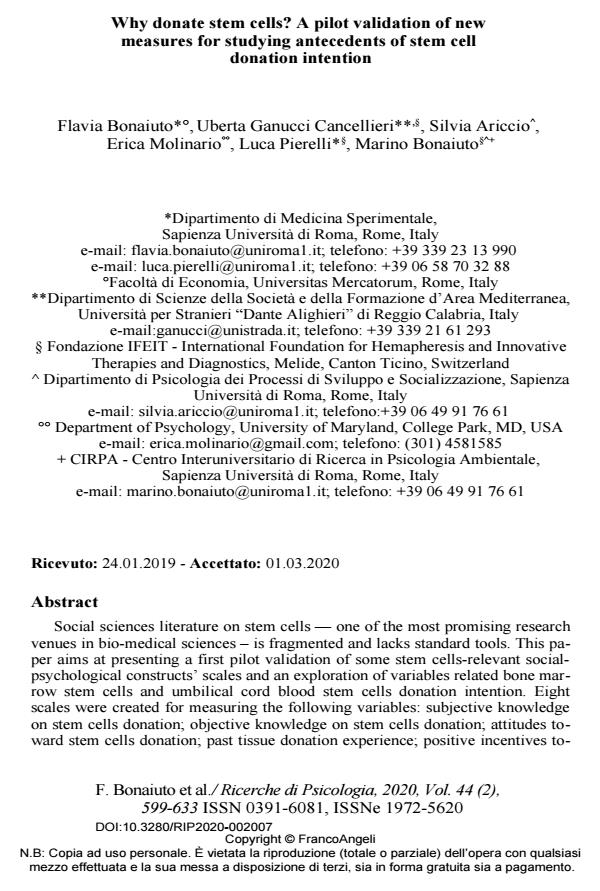Why donate stem cells? A pilot validation of new measures for studying antecedents of stem cell donation intention
Journal title RICERCHE DI PSICOLOGIA
Author/s Flavia Bonaiuto, Uberta Ganucci Cancellieri, Silvia Ariccio, Erica Molinario, Luca Pierelli, Marino Bonaiuto
Publishing Year 2020 Issue 2020/2
Language English Pages 35 P. 599-633 File size 369 KB
DOI 10.3280/RIP2020-002007
DOI is like a bar code for intellectual property: to have more infomation
click here
Below, you can see the article first page
If you want to buy this article in PDF format, you can do it, following the instructions to buy download credits

FrancoAngeli is member of Publishers International Linking Association, Inc (PILA), a not-for-profit association which run the CrossRef service enabling links to and from online scholarly content.
Social sciences literature on stem cells one of the most promising research venues in biomedical sciences is fragmented and lacks standard tools. This paper aims at presenting a first pilot validation of some stem cells-relevant social-psychological constructs’ scales and an exploration of variables related bone marrow stem cells and umbilical cord blood stem cells donation intention. Eight scales were created for measuring the following variables: subjective knowledge on stem cells donation; objective knowledge on stem cells donation; attitudes toward stem cells donation; past tissue donation experience; positive incentives toward stem cells donation; negative incentives toward stem cells donation; intention of stem cells donation; importance of stem cells sustainabil-ity. A self-report questionnaire including new scales and existing scales from literature (norms, values, emotions) was administrated to 78 Italian subjects. Fac-torial structures were explored via factorial analyses with Principal Axis Factor-ing, Oblimin rotation and Cronbach’s alpha tests. Two stepwise regression anal-yses were conducted to explore which variables are more related to the two kinds of donation intention. Most scales have been found to have a satisfacto-ry factorial structure and internal consistency (a>.60). Both kinds of donation intention have been found to be associated to self-transcendence values and positive emotions; bone marrow stem cells donation intention is also associated to conservation values, subjective knowledge, and past tissue donation experi-ence. Results are discussed according to current literature and suggesting re-search developments.
Keywords: Altruism, stem cells, donation, donoridentity, social-psychological tools.
- Stay at home behavior during COVID-19: The role of person-home relationships Silvia Ariccio, Annalisa Theodorou, in Journal of Environmental Psychology 102334/2024 pp.102334
DOI: 10.1016/j.jenvp.2024.102334 - Problematic donation procedures vs. futuristic research and treatment applications: A dichotomous social representation of stem cells in Italy Silvia Ariccio, Uberta Ganucci Cancellieri, Flavia Bonaiuto, Roberto Fasanelli, Ida Galli, Luca Pierelli, Marino Bonaiuto, in European Review of Applied Psychology 100763/2022 pp.100763
DOI: 10.1016/j.erap.2022.100763
Flavia Bonaiuto, Uberta Ganucci Cancellieri, Silvia Ariccio, Erica Molinario, Luca Pierelli, Marino Bonaiuto, Why donate stem cells? A pilot validation of new measures for studying antecedents of stem cell donation intention in "RICERCHE DI PSICOLOGIA " 2/2020, pp 599-633, DOI: 10.3280/RIP2020-002007